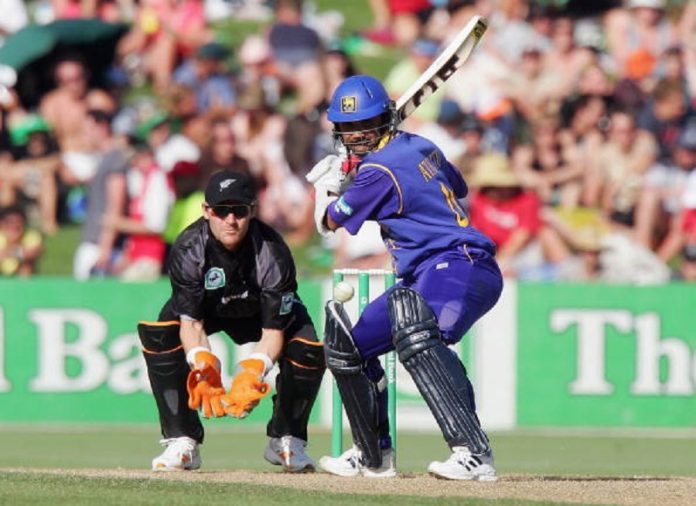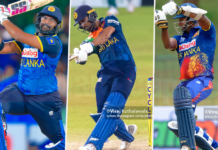The name itself drags us back into memory lane with elegant cover drives, pinpoint accurate technique and marathon run gathering innings.
Free hit contributor – Kasun Ekneligoda
Marvan Atapattu was one of the finest technically sound batsmen ever to grace Sri Lankan cricket. Hang around with cricket fans be it from home or abroad, it will only be praise you hear when you chat on “Atapattu”. He was a treat to watch and gave pure agony to the opposition. But the way cricketing years went on for him was so checkered that even his wildest dreams wouldn’t have visualized it.
Schoolboy Cricketer of the year
Born in Kaluthara in 1970, he started his cricketing career for Mahinda College, Galle. Showing immense promise and raw talent at such a young age, he made an immediate impact in the schools cricketing arena, coming onto the radar of many popular schools from Colombo. Marvan was recruited to Ananda College Colombo. He went on to play senior level cricket at U-17 and U-19 for the maroons, piling on runs at will. After a staggering batting display at the U-19 level, Marvan was crowned the “The Sunday Observer Schoolboy cricketer of the year” in 1990.
Read – Coaching is more challenging than playing: Atapattu
Appalling kick off to the big stage
Being a talented youngster with oozing potential, Marvan was picked for Sri Lanka’s tour of India in 1990. He made his test debut at Chandigarh vs India as a 20-year-old. Being a fresher to the side, he was sent in at number 7 to bat, unusual territory for the top order batsman. Having a torrid time in the middle, he succumbed without scoring a single run. The second innings was no different as he bagged a pair. He also made his ODI debut during the same tour at Nagpur, scoring 8 runs as Sri Lanka failed to chase India’s total. Marvan was dropped from the team immediately and was forced to raise his game to suit the international level. After a gritty effort of 21 months, Atapattu was recalled to the side for a test against Australia. Result? Another duck and a single!! The selectors had given him another two years when he was again given the privilege of wearing the Sri Lankan crest against India. Result? A duck and another duck! Being a sensation at schoolboy level, this horrendous performance raised many eyebrows on whether Marvan was not international material and would ever play for the Islanders. He had scored just a single run from 6 test innings, nowhere near what was expected from a player of his caliber. He was in an out of the ODI team as well and didn’t fare well in the white ball game, making no significant impact. The nation sighed thinking another hyped player had gone down the drain.
Read More – The debate on foreign versus local coaches
The comeback to glory
Atapattu, had been gradually disappearing from the cricketing picture after being unable to find his groove. Being never recalled for test cricket after his two failures, he had been a spectator for most of his time in the ODI side too. It was in 1996/97 Singer Cup in Sharjah when he found his touch. He started to show glimpses of his school days, toiling the opposition as he scored three half centuries in the tournament against Pakistan and Zimbabwe. With his form improving day by day and scoring heavily at first class level, the selectors decided to give it one last crack. Marvan was recalled to the test side against New Zealand. It wasn’t glorious. But it was a sigh of relief as Marvan crept his way to a 25 and a 28 as the Kiwis looted the visitors at Dunedin by an innings. With runs starting to flow from his bat, he finally had a chance to reserve his place in the squad. All his efforts ultimately payed dividends when Sri Lanka toured India, where he scored his maiden test ton in Chandigarh, ironically at the same venue where he made his horrific test debut. Caressing a 108, he dragged Sri Lanka to a total of 369, earning them a draw. Since then Marvan Atapattu became a permanent member for the red ball and white ball game for Sri Lanka and he chipped in regularly with his class to march Sri Lanka towards triumph.
Branded technique and walk to captaincy
With occasional glitches to his form, Marvan Atapattu made sure not to re-experience the terror at the start of his career. He scored his first double hundred against Zimbabwe at Kandy in 1998 and he went on to score six of them in his entire test career, reinforcing the fact that he wasn’t just a minnow basher at school level. Possibly his greatest cricketing moment with the white ball arrived in 1998 at Lord’s when he dashed the entire arsenal of English bowling with a 128, in a successful chase in the final of the triangular series with England and South Africa, earning Sri Lanka the title.
After Romesh Kaluwitharana faded as an opener, Marvan was asked to fill his boots and he did establish himself with Sanath Jayasuriya as a world class opening pair, complementing each other in their own way. While Jayasuriya was blasting his way through, tearing bowling attacks apart, Atapattu steadied the ship with his class and elegant technique. The pair gave many opening stands for the team cruising their way to glory. The “Marvan-Sanath” opening partnership was a signature during arguably the golden era of Sri Lankan Cricket from 2000-2003. With Sanath Jayasuriya stepping down as the captain in all formats, Marvan Atapattu was appointed the captain of the ODI side in 2003 and he took on youngsters such as Mahela Jayawardane, Kumar Sangakkara and newcomer Lasith Malinga under his wing. A year later, he was appointed to lead the test side too. 2004 was a glorious period for both Marvan and the team as he racked up two double centuries in test cricket as the captain and Sri Lanka won the Asia cup and whitewashed the Proteas 5-0. Marvan Atapattu was eventually named the captain of the World ODI IX named by the ICC in 2005, replacing Ricky Ponting.
Injuries and disputes
Inn 2004 Sri Lanka cricket appointed a new chief selector Ashantha De Mel. De Mel, right from the start was not fond of Atapattu’s tactics and wanted to feed in fresh blood to the team. He slammed Marvan and the coaching staff on the eve of a triangular series final in Pakistan questioning their tactics and attitude. Though Sri Lanka beat Pakistan in the final, Marvan’s relationship with the selection committee was bitter from there on. But worse was yet to come as he got a back injury and was ruled out of a tour to the Caribbean in June 2005. Mahela Jayawardane, then a bright prospect, was appointed the stand-in captain. Marvan was in and out of the side for a couple of times in 2006, but his back injury plagued him over and over again. The selectors then made the decision to appoint Mahela as the permanent captain for all formats. Even though Marvan came back to the side, he was never offered the chance to lead the side since his successor was producing results beyond expectation. Marvan was never the player he used to be and hardly performed to make an impact since his return and was benched for most of the games even when he made it to the squad. He was made to be a mere passenger at the 2007 ICC Cricket World Cup as he was the only member of the squad not to wear Sri Lankan colours for a single game. His final call up was as an emergency replacement for a test series versus Australia in 2007/08, when Marvan went out in a press conference to express his resentment against de Mel and co.
Marvan said,
“Sri Lanka cricket at this moment of time is not going in the direction it should be going, especially with a set of muppets headed by a joker. I don’t give credit to the way they have handled selections.”
“If they had handled selections properly we should have a good back-up team. For some reason we don’t and at the age of 37-38 people have to come and play for Sri Lanka when it comes to tough tours like this. If selectors are there only for going on tours and getting perks it is a waste of time.”
Retirement and Coaching
Marvan announced his retirement immediately after the tour and in his last innings for Sri Lanka, he scored a sublime 80 in a failed chase against the Aussies as Sangakkara’s 192 went in vain. He then signed up for the unofficial Indian Cricket League in 2008, causing him to get banned from playing any form of cricket in Sri Lanka or elsewhere. Eventually the ban was lifted in 2009 making him free to play for his club but he never returned as a player to play domestic cricket. Marvan then went into to coaching, ultimately becoming the head coach of the national team for the stint of 2014-2016.
In 90 test matches, Marvan scored 5502 runs scoring at an average of 39.02. While representing Sri Lanka in blue, he appeared in 268 ODIs scoring 8529 runs at an average of 37.57. This is still the 3rd highest ODI average for a retired player in Sri Lankan cricket history. With a rollercoaster ride, his career was not a walk in the park. With failure written all over him by critics, he rose like a phoenix from the ashes to stamp his authority in Sri Lankan Cricket history. Among many great batsmen this tiny island of Sri Lanka was blessed with, we will always remember this elegant silent assassin named “Marvan Samson Atapattu”.
*Disclaimer: The views and opinions expressed in this article are those of the author’s and do not necessarily reflect the official policy or position of ThePapare.com.
If you have an opinion on Cricket – you get a Free Hit here. Write to [email protected] to be featured!
















